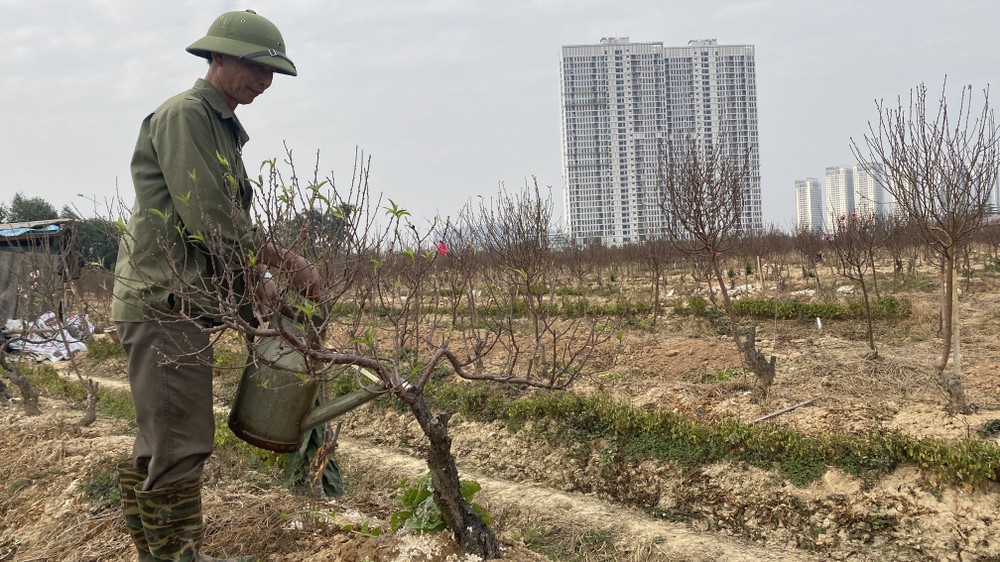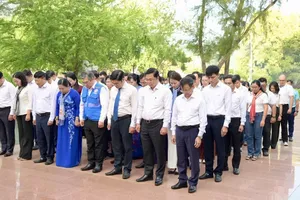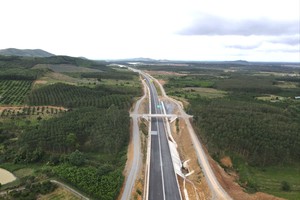
Severe damage
More than a month ago, farmers in the outskirts of Hanoi and in Bac Giang, Bac Ninh, Hai Duong, Nam Dinh, and Phu Tho provinces began plucking peach leaves to ensure timely blooming for Tet. However, with less than two weeks to go, many traditional peach fields around Hanoi remain bare, their branches blackened and lifeless.
Nguyen Van Thinh, a peach grower in Dai Mo Ward (Nam Tu Liem District), shared his frustration, “This year, we’ve lost the Tet peach blossoms.” Holding up a peach branch, he pointed to tiny buds no larger than sesame seeds or charred grains of rice. At this stage in previous years, these buds would have already developed into flower buds, growing to the size of mung beans or corn kernels. This year, however, 80-90 percent of the peach trees in the field won’t be ready in time for the Tet market.
At the La Ca peach field in Duong Noi Ward (Ha Dong District), a few city traders visited about 3-4 days ago to survey prices and flower quality. Yet, farmers and garden owners were noticeably absent compared to previous years. Most peach trees here are unlikely to bloom in time for Tet. “By this time last year, the flowers were already in full bloom,” said Le Van Hong, a veteran peach grower in the Doan Ket area of Duong Noi Ward.
Regarding this year’s unusually late blooming, Hong and other farmers attributed it to typhoon Yagi in September 2024. After the storm, many peach trees were severely stunted due to root damage, with some trees dying altogether. Over the past two weeks, frost in Northern Vietnam has worsened the situation, further delaying the blooming process.
Le Van Phat, the owner of a peach blossom garden with over 500 trees in An Khanh Commune (Hoai Duc District), noted that this year, not only are ornamental peach blossoms in Hanoi blooming late, but wild peach blossoms in the Northwest are also behind schedule. He attributed this primarily to the prolonged cold weather in Northern Vietnam over the past month. Fearing a repeat of last year, when warmer weather caused early blooms, most growers delayed leaf-plucking by 5-10 days. Phat remarked that if the leaves had been stripped earlier, the flowers might not have been delayed like this.
At his peach blossom garden with over 600 trees in Ngai Cau Village (An Khanh Commune, Hoai Duc District), where hundreds of other gardens also face the risk of losing their Tet flower crop, Dinh Van Trong shared his worries. His family’s annual income relies heavily on the Tet peach blossom season, and the thought of the flowers failing to bloom is alarming. Typhoon Yagi had flooded his fields, killing over 50 percent of the peach trees, with other families suffering similar losses. As a result, farmers are enduring a double blow this year.
Hoping for higher prices to offset losses
Trong and other peach blossom growers in the area remain hopeful that the Tet crop can still be salvaged by continuously pumping warm water into the fields during the week leading up to the Kitchen Gods’ Day. If done consistently, buds could begin appearing around the 26th or 27th of the last lunar month this year.
However, farmers must carefully monitor the weather. If the cold remains severe, with temperatures staying between 10 degrees Celsius and 14-15 degrees Celsius, it will be too late. On the other hand, if the weather warms and the sun appears, the process of forcing buds and nurturing flowers will be much smoother. Despite these efforts, the quality of this year’s peach blossoms is unlikely to match that of previous years.
In the Nhat Tan and Phu Thuong areas of Tay Ho District (Hanoi), Tet flowers have been arriving at markets over the past one to two weeks. Orchids from Da Lat and wild peach blossoms from the Northwest are now available. However, typhoon Yagi caused significant flooding and damage in the Nhat Tan peach blossom gardens, leading to a sharp decline in supply. Many garden owners report that the number of peach blossom trees this year is only about one-third of what it was in previous years.
With peach and kumquat crops heavily affected, many traders expect prices to rise by 10 percent to 30 percent this year. Tet peach blossoms are projected to range from VND1-2 million for regular trees to VND8-10 million for special trees with unique shapes.
In addition to traditional peach blossoms, this year’s market features unique, high-priced imported flowers to cater to the diverse preferences of consumers.
Farmers face devastating losses
In Hanoi, the Nhat Tan peach blossom village (Tay Ho District), a traditional peach-growing area covering about 105 hectares, has suffered severe impacts from typhoon Yagi in 2024. Flooding from the storm affected approximately 30 percent of the cultivated area.
In Dong Trieu City (Quang Ninh Province), more than 330 hectares are dedicated to growing peach blossoms, kumquats, and other flowers. The hardest-hit area, Binh Khe Ward, saw over 200 hectares of peach and kumquat trees damaged by typhoon Yagi.
In Ba Sao Ward (Kim Bang Town, Ha Nam Province), the peach blossom hub of the province, yields are significantly lower than in previous years. Dang Cuong Commune in An Duong District, Hai Phong, is a center for flowers and ornamental plants, with about 90 hectares of peach blossoms.
According to the Dang Cuong People’s Committee, 80 percent of the peach-growing area was completely wiped out after typhoon Yagi. Only 10 percent of the trees can be salvaged for the Tet market, but their quality is poor. With Tet peach blossoms priced at VND25-30 million for large trees, VND7-10 million for medium-sized ones, and VND1.5-5 million for smaller ones, each peach grower in the commune has faced losses ranging VND500-700 million this year.
























